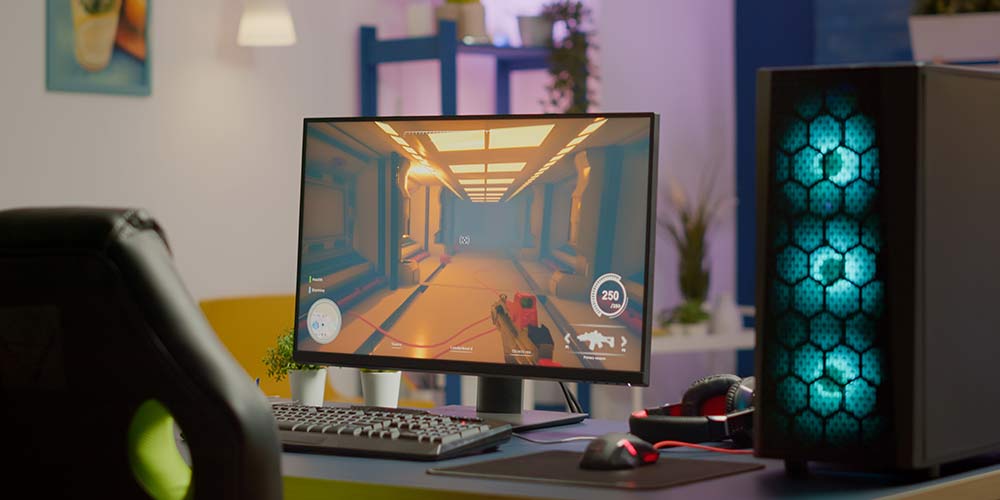
Gaming Monitor – Best of 2022
SELECT THE RIGHT MONITOR
Whether you’re a very passionate PC gamer or a part-time after-hours player, you both need the right gaming monitor.
Your hardware may be the pivot point between victory and defeat.
To maximize the recent first-person shooter (FPS), sports, racing, and other fast-action games.
You’ll not only need a gaming PC with a strong graphics card.
You will also need a monitor that may enhance the action without blurring images, flickering, tearing, and other motion defects.
Choose a display that offers you a foothold over your opponents while delivering a smooth, immersive gaming experience.
These are the factors to think about when choosing a gaming monitor.
Monitor Panel Size and Resolution
When it involves gaming monitors, bigger is nearly always better.
That said, in some select cases, you’ll want to keep the scale of your monitor at 27 inches or under.
If you have followed esports tournaments lately?
You’ve probably noticed that every one of the players is playing on screens smaller than that size.
Why does a 24-inch seem to hit the sweet spot?
If you’re playing a highly competitive title like Counter Strike: Global Offensive or League of Legends,
Having a smaller screen means you’ll be able to keep the monitor much closer to your eyes.
Therefore, keep more of the frame in view.
Having the ability to determine every element on the screen directly could be a vital advantage in a very competitive multiplayer environment.
The larger the screen size that you select, the tougher it’s to keep every enemy combatant in your visuals.
Monitor Panel Technology
You’ll see several main monitor-panel technologies employed on various gaming monitors.
Each and every monitor-panel has its pros and cons.
Twisted nematic (TN) panels are one of the most affordable and are popular among gamers because they provide fast pixel response times and refresh rates.
Their biggest drawback is they’re at risk of color shifting when viewed from an angle.
Vertical alignment (VA) screens have robust colors, high native contrast ratios and can display deep black colors.
However, they’re also known to provide noticeable ghosting effects, which may hurt gaming performance.
In-plane switching (IPS) panels provide the most effective all-around color quality, strong grayscale performance, and wide viewing angles.
However, they can’t match the pixel response of TN panels and are subject to motion artifacts.
Although they’re the most effective general-use panel type, judgmental gamers may have an issue with IPS.
This trend is starting to change, however.
LG has developed an updated IPS panel (dubbed “nano IPS”) that claims 1-millisecond gray-to-gray reaction time with overdrive turned on.
Therefore, the first monitor to feature this technology is already on the market, the LG 27GL850.
Input Lag, Refresh Rate and Pixel Response
Gaming monitors should have a quick pixel reaction time and a high refresh rate.
Commonly, the most used pixel response specs are gray-to-gray, which in turn is measured in milliseconds (ms).
It signifies the amount of time that it takes a single pixel to transform from one particular shade of gray to another.
There are a few companies that still use the older black-to-white measurement.
A very low pixel response will help eliminate the smearing of moving images and supply a smoother picture than a higher pixel response.
A gray-to-gray response of 2ms or less is right.
Although even a 4ms gray-to-gray response is usually adequate for gaming.
Input lag is another important factor to contemplate when buying your next gaming monitor, especially for competitive players.
Input lag refers to the quantity of time it takes for an action to come up onscreen.
G-Sync and FreeSync – Technologies in Flux
The latest gaming monitors use synchronization technology.
It helps to reduce tearing and other motion artifacts while it lowers input lag.
All the displays that are equipped with Nvidia’s G-Sync or AMD’s Free Sync technology will hand off control of the screen.
The actual result is a smooth gaming experience, with decreased input lag and an absence of tearing.
However, you must note, that G-Sync and Free Sync gaming monitors will require a G-Sync- or Free Sync-compatible graphics card.
HDR – Brightness Deluxe
HDR technology is not only for creating movies, and television shows will look good.
They will turn a dimly lit, washed-out game into something vibrant, filled with contrast, with sharply defined edges.
There are only four levels of HDR in monitors at this moment: Display HDR 400, Display HDR 600, Display HDR 1000, and Display HDR 1600.
The figure refers to the quantity of nits, or the different levels of brightness.
Ensuring that the display should be capable of maxing out.
Video Inputs and Other Features
A gaming monitor should be equipped with a wide range of video inputs.
So that you are able to stay connected to multiple PCs and gaming consoles.
Dual HDMI ports are ideal, since the main game consoles use HDMI.
However, most high-end graphics cards offer DisplayPort and HDMI connectivity.
DVI is usually still there, but it’s falling away from the highest-end cards….
A few extreme enthusiast monitors, like the Acer Nitro XV3, actually require two DisplayPort 1.4b cables.
They are plugged in directly to pipe a 4K 144Hz signal from a PC to the display.
So far, this can be the only model on the market that we have seen that has this requirement to induce the complete signal.
If you intend on buying this display specifically, we recommend ensuring that your GPU has two DisplayPort 1.4b outputs to support it first.
